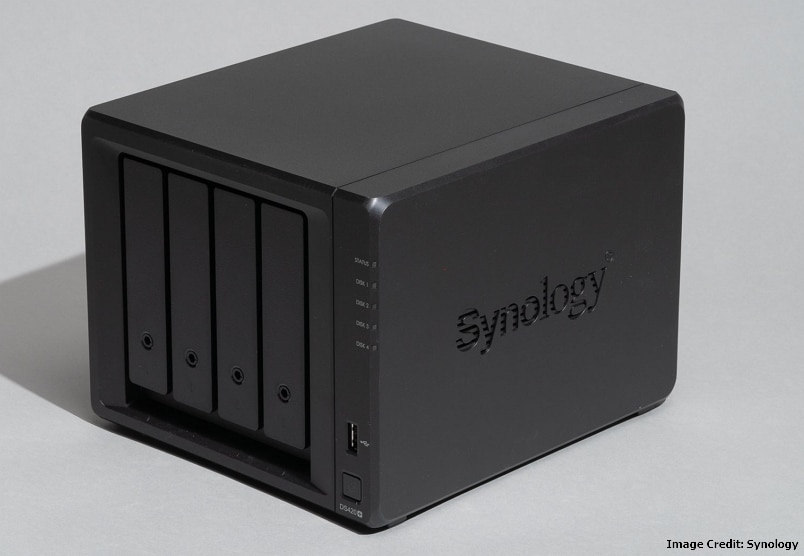
Even though data has proven valuable, companies face many challenges regarding it. Some of them don’t have the necessary IT staff. There are also access issues and storage problems. With NAS systems, most of these problems have disappeared.
What is NAS, and how does it help with these issues? Today you will get all the essential information about NAS and understand whether these solutions are the right choice for you.
In this article
Part 1. What Is NAS Storage?
NAS is short for network-attached storage, representing storage devices connected to a network that provides file access to other computers. NAS systems are centralized, and only authorized networks can access the files in this storage.
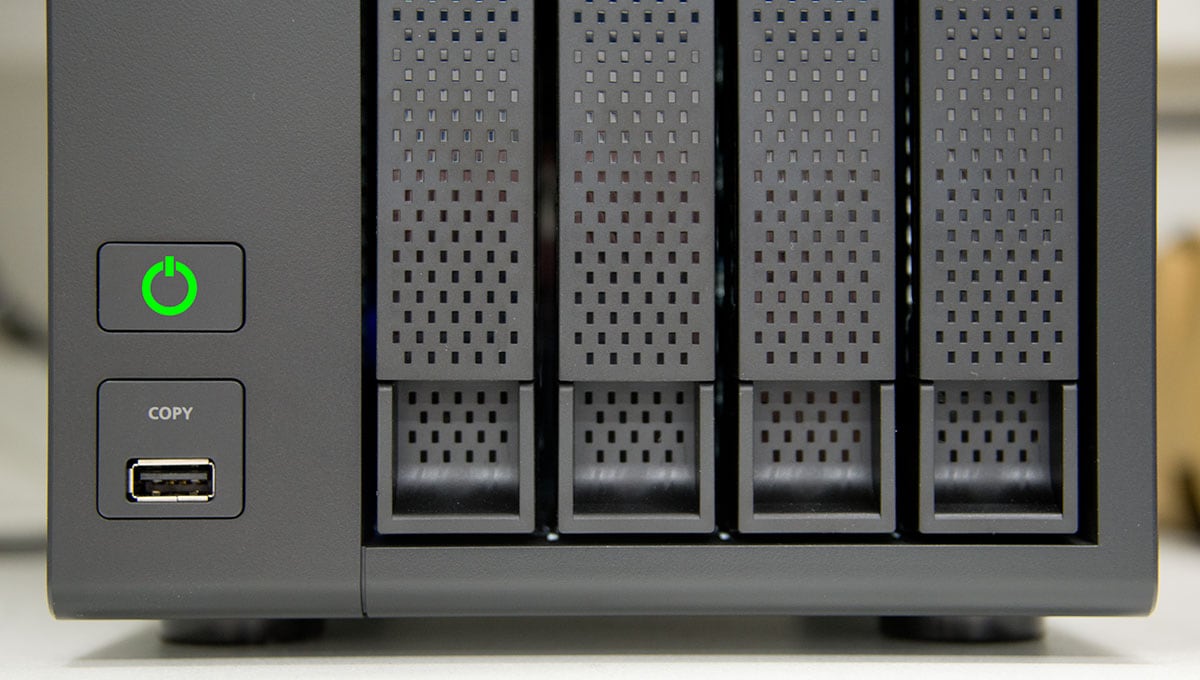
NAS devices are scalable and flexible. A company must add more devices to its storage network if it needs more storage.
What is NAS storage in simple terms? It’s a private cloud with physical storage. NAS gives all the benefits of public clouds but with lower costs and more control.
NAS was created during the ‘80s and evolved from file servers for network clients. For NAS devices to enable operations, they come with bundled software and hardware driven by an operating system.
Part 2. How Does NAS work?
Many people don’t understand what NAS storage is capable of because they don’t understand the architecture. These devices have several components in their architectures that enable them to store and retrieve data quickly.
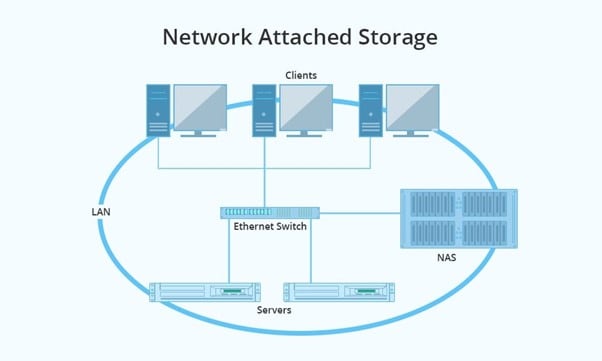
Operating systems
NAS devices must have a built-in OS to handle all the tasks they are designed for. Operating systems also help run applications like CRMs, ERPs, productivity tools, web servers, software development tools, file-sharing applications, etc.
Computer devices
All NAS devices have a CPU (Central Processing Unit), giving them computing intelligence to manage users, run apps, and read, write, manage, and process files.
Networking capabilities
The word “network” is in the name for a reason: it allows NAS systems to connect to computers. Some of them even have USB ports to enable alternative data transfer capabilities.
Storage drives
Since the primary function of NAS devices is to store files, they must have storage drives. In most cases, hard drives give the most storage space and speed.
NAS Usage
What are the use cases of network-attached storage? In general, NAS systems store unstructured data. This data can be emails, images, backups, files, videos, etc. Network-attached storage is very convenient for high-performance computing environments.
The primary use cases of NAS devices include editing video data, video storage in government agencies, data analytics in the financial sector, record maintenance, etc.
NAS usage is also common in the entertainment and media industry as they constantly generate new unstructured data. Here are all major use cases of NAS storage:
● Securing premises
IP cameras are affordable but often unsecured. Using a good app and NAS, you can centralize the feeds into a single control panel, see recordings, manage recordings, and get live alerts of suspicious activity.
● Storing photos and videos
Many photographers and videographers take hundreds of shots daily. Instead of having to use services like Flicker, these professionals can set up their NAS storage centrally to store materials and stream them on various devices without quality or storage limitations.

● Building a website
Most NAS app platforms offer Drupal, Joomla, and WordPress, and these CMSs can be installed and used on NAS systems. That allows developers to add content, test websites, and try out different templates before migrating their sites to a hosted platform.
● Building cloud systems
Most NAS brands support services like Google Drive, OneDrive, and Dropbox, meaning users can download and upload files through browsers and sync files using a dedicated client. NAS storage allows users to run their personal cloud storage with better access control.
● Deploying office suites
Office suites offer various benefits, but there’s also a risk of getting locked into a vendor’s ecosystem and high ongoing costs. Some NAS vendors offer collaborative office suits which run directly from NAS devices with absolute control.
● Setting up email servers
If you need to run a business or personal email, NAS devices let you do this through various apps with the ability to check messages from a browser.
● Managing and downloading torrents
Many users rely on NAS devices to manage torrents through a file-sharing client. NAS manages all uploads and downloads while the PC is free of these commitments. In other words, NAS can work in the background on torrenting tasks while you do something else.

● Development and testing
Server and web developers use NAS environments for server-side apps as there are many APIs available. Users can install apps for project management or version tracking.
Types of NAS
NAS devices can be different regarding storage space, speed, how many devices can use them, and other features. There are three types of NAS, and all of them are different.
1. Consumer NAS systems
These devices are designed for “regular individuals” and offer connectivity for around 20 people with 20 TB of storage. People usually use these devices for streaming, sharing files, and backups. In most cases, they don’t offer cloud backups or support clustering or RAID.
2. Midmarket NAS systems
Smaller and mid-sized companies use midmarket NAS devices, which offer storage running from 20 to 64 TBs. They use them for sharing, streaming, backups, hosting editing, data logging, video recording, accounting, and email systems.
Unlike consumer-level NAS, they offer virtualization and RAID capabilities with cloud backups but usually don’t have clustering capabilities.
3. Enterprise NAS systems
Over 1,000 clients can use enterprise NAS systems, which offer petabytes of storage space. They have virtualization and RAID capabilities with clustering. Enterprise NAS provides remote data access, has exceptional cloud backups, and you can use it for all operations.
Types of NAS |
Number of users |
Storage capacity |
RAID support |
Clustering |
Backups |
Common uses |
| Consumer NAS | Up to 20 users | Up to 20 TB | / | / | / | Streaming,sharing, and backing up |
| Midmarket NAS | From 20 to 1000 | From 20 to 64 TB | RAID and virtualization | Rarely | Cloud backups | Data logging, editing, video recording, accounting, email systems, and payroll management |
| Enterprise NAS | Over 1000 users | Petabytes | RAID and virtualization | Clustering available | Cloud backups | Same as midmarket on an enterprise level |
NAS Protocols
NAS systems use software and hardware with protocols to facilitate file sharing using networks. Using these protocols, any computer with authorization can access NAS files, store additional files, or retrieve data. Here are the protocols that enable these operations.
Formatting protocols
Devices within a single computer network have different operating systems; they all need to access NAS files in their original format. That’s why NAS systems format data before sending it out using several protocols:
Communication protocols
Networks have many data transfer protocols, but most use TCP and IP. TCP (Transmission Control Protocol) creates data packets and sends them through the network, while the IP (Internet Protocol) pinpoints the address where the data is sent.
Comparing NAS vs. SAN vs. DAS
The first significant difference between these three is the storage mechanisms they use.
NAS devices use shared files, SAN (Storage Area Network) devices have block storage, and DAS (Direct-Attached Storage) devices have hard storage. Because of these mechanisms, all of them have different storage-sharing capabilities, scalability, and costs.
At the same time, each storage system has different data transmission technologies:
- NAS: TCP/IP & Ethernet
- SAN: IP & Fibre Channel
- DAS: IDE/SCSI
Further Reading:
NAS vs SAN
NAS vs DAS
Part 3. Why Should You Use NAS?
Seamless access to multiple devices
NAS systems allow you to collaborate and share data with multiple devices easily without installing additional tools. It’s a private cloud you can share with anyone according to your needs. It places all the data in a centralized location so all authorized users can access it anytime.
Cross-platform access
Most NAS devices allow access using the most popular operating systems, including Windows, Linux, and macOS. All files are formatted according to the OS before being sent with a formatting protocol.
Data backups
Any serious business or individual understands the importance of regular data backups. You never know when your computer or hard disk might crash. NAS devices let you configure backups to ensure your data is available in any scenario.
Reliability
Having isolated data storage is much safer since power loss, spilling a drink on your laptop, or having a PC crash can’t compromise your data. At the same time, these storage solutions offer robust security features.
Easy to set up
Most of the modern NAS hard drives are out-of-the-box solutions that require you to turn on the device and run an installation wizard to set up your external storage.
Part 4. Why Should You Avoid NAS?
It’s expensive.
Even though NAS doesn’t involve any maintenance and setup costs, depending on your needs, these devices can have a high cost. That is especially true for enterprise solutions that offer massive storage and functionality. Some of the best consumer-grade NAS systems cost around $250, while enterprise solutions can go up to $5000.
Poor onsite backup
NAS storage can back up all your hard drives, but there’s no backup for the data you’ve stored on this device. In other words, it’s also a liability even though the chances of losing this data are lower.
However, you can overcome this issue using the 3-2-1 backup strategy, where you can keep 1 copy of your data off-site, store data on two different types of media, and have three copies in total.
In this case, you can keep the original data on NAS while keeping copies on your computer and on the public cloud. You will use both NAS storage and the public cloud as two different media while having a NAS device as offsite storage.
Not the fastest option
NAS generally offers higher latency and lower throughput because of its file system layer. Still, a company can compensate for this lost performance using high-speed networks.
Difficult to recover files from Linux
Most NAS use Linux-based OSs because of their security capabilities. However, recovering Linux files from local storage can be challenging. Luckily, there are Linux file recovery tools you can run through Windows and Mac to recover files from Linux systems.
Part 5. How To Choose a NAS Solution
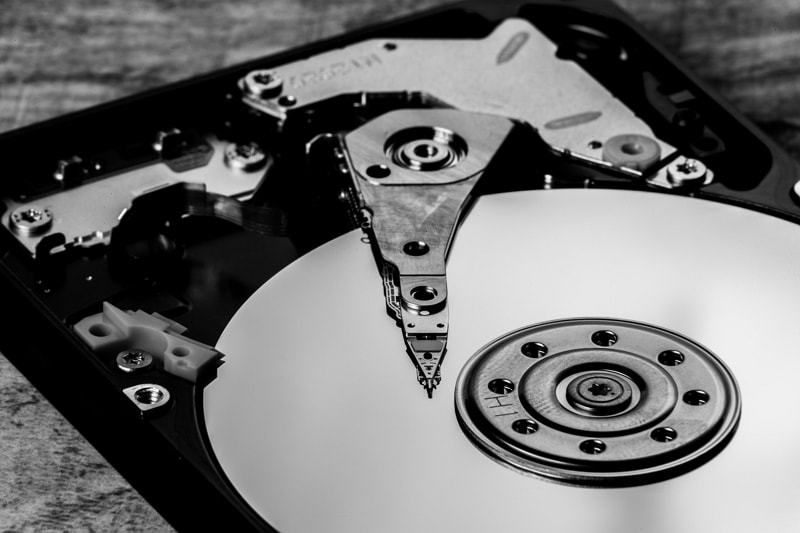
Before buying a NAS, you must consider several factors to get the right solution for your business needs. Not all of these storage solutions are suitable for all applications, and the first important factor is the form of the actual device.
Physical shape
NAS devices have different physical characteristics, including size and shape. There are two main variations of NAS storage: tower and rack-mount devices. Rack cases are better for enterprise applications as they can be expanded easily, while tower variations are better for smaller needs.
Storage capacity
When choosing a NAS unit, consider the number of supported drives. The number of disk bays can range from a single slot to 16. First, check if the device supports RAID – this is a clear indicator that you can use multiple drives in a single storage.
Units with four bays and higher support RAID 6 and RAID 10, while units with two drives offer mirror images of the original drive. NAS units with at least three drives give you better redundancy and capacity, while four-unit drives require more redundancy space but have better capacity.
Security features
Many NAS devices are used to allow remote access to various users. That’s why you must ensure people without authorization won’t access your data. Look for units with advanced encryption features like AES 256-bit encryption.
Performance benchmarks
NAS solutions are designed for file access and data storage. That means they need powerful processors to do their jobs properly. Speed is the most important factor when multiple people connect to the same network.
CPU is the first consideration, and the power you need depends on your needs. You need around 2GHz of power with two threads if you have a simple home setup. On the other hand, more complex needs and multiple-user access requires at least 4 GHz of power with 4 threads.
At the same time, consider the performance of each thread. As far as RAM goes, there’s a basic principle that works for everyone. For each TB of storage, you should have at least 1GB of RAM.
Top NAS Vendors
The NAS market is proliferating, with new vendors popping up constantly. Users will be happy to know that they will have more options in the future due to all this competition. Estimates show that the growth from 2022 to 2028 will be at a CAGR of 12.1%.
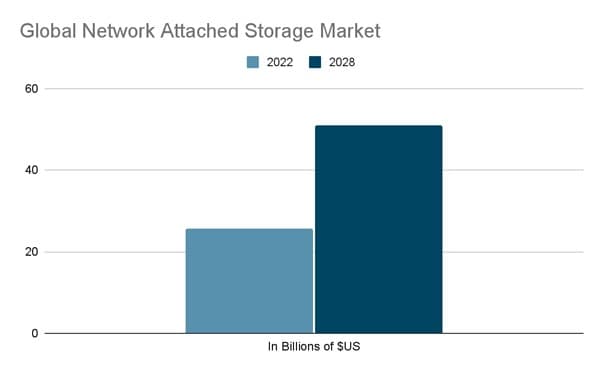
Like in any other industry, some brands or vendors stand out from the rest in terms of quality. According to TrustRadius, you will want to get a NAS system from one of these vendors:
- Synology
- QNAP
- TerraMaster
- Asustor
- ioSafe
Conclusion
If you need access to your data from multiple devices, you should use NAS. It’s an excellent centralized storage option for individuals and organizations with superb features overall.
However, if you’re looking for long-term backup, it’s probably better to go with cloud services that can offer you the right services at a fraction of the price.
For Windows Vista/7/8/10/11
For macOS X 10.10 or later

 ChatGPT
ChatGPT
 Perplexity
Perplexity
 Google AI Mode
Google AI Mode
 Grok
Grok























